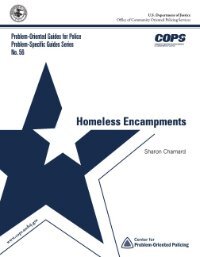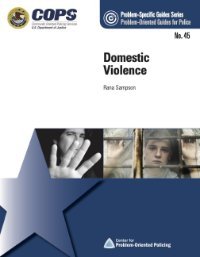This guide addresses homeless encampments, also known as transient camps. It begins by describing the problem and reviewing factors that contribute to it. It then identifies a series of questions to help you analyze your local problem. Finally, it reviews responses to the problem and what is known about them from evaluative research and police practice. Homeless encampments are only one aspect of the larger set of problems related to homelessness, street life, and public disorder.
This guide begins by describing the problem of home invasion robbery and reviewing factors that increase its risks. It then identifies a series of questions to help you analyze your local home invasion robbery problem. Finally, it reviews responses to the problem and what is known about these from evaluative research and police practice. Home invasion robbery is but one aspect of the larger set of problems related to residential and violent crime. This guide is limited to addressing the particular harms created by home invasion robbery.
This guide begins by describing the problem of hate crimes and reviewing factors that increase its risks. It then identifies a series of questions to help you analyze your local hate crimes problem. It reviews responses to the problem and what is known about these from evaluative research and police practice. Specifically, it describes what you can do to reduce underlying tension in the community that contributes to hate crimes. This guide also outlines what the police can do to address any special fear and trauma experienced by the individual victim and the racial, ethnic, religious, or sexual orientation community to which the victim belongs. Finally, it reviews the police role in monitoring hate groups that have members and conduct activities in your community.
This guide addresses serious youth gun violence, describing the problem and reviewing factors that increase the risks of it. It then identifies a series of questions that might help you analyze your local problem. Finally, it reviews responses to the problem, and what is known about them from evaluative research and police practice. Criminal misuse of guns kills or injures tens of thousands of Americans every year. In 2000, more than 10,000 Americans were killed with guns, and guns are much more likely to be used in homicides of teens and young adults than in homicides of people of other ages.
This guide deals with the problem of false burglar alarms. It begins by reviewing factors that increase the risks of false burglar alarms. It then identifies a series of questions that might help you analyze your local problem. Finally, it reviews responses to the problem and what is known about them from evaluative research and police practice. False burglar alarms is but one aspect of the larger set of problems related to alarms and misuse of police resources. This guide is limited to addressing the particular harms created by false burglar alarms.
This guide begins by describing the problem of drunk driving§ and reviewing the factors that increase its risks. It then identifies a series of questions that can help analyze local drunk driving problems. Finally, it reviews responses to the problem of drunk driving and examines what is known about the effectiveness of these responses from research and police practice. Simply put, drunk driving is a police concern because alcohol increases the risk that drivers will get in traffic crashes and kill or injure themselves or others.
This guide begins by describing the problem of drug-impaired driving and reviewing factors that increase its risks and negative outcomes. It then identifies a series of questions to help you analyze your local drug-impaired driving problem. Finally, it reviews a number of responses to the problem and summarizes what is known about these responses from evaluative research and police practice. Drug-impaired driving demands police, legislative, and community attention because of the harms it may cause.
If you have an apartment complex in your community where drug dealing is occurring, you may have found that simply making arrests has not closed the drug market. What else could be done? Why is this problem occurring? What conditions facilitate the drug market's operations, and what remedies will work best? This guidebook addresses these issues. It describes the types of drug markets found in apartment complexes and provides questions to ask when analyzing those markets. It suggests ways to encourage property owners to take more responsibility for problems. Finally, it summarizes the full range of measures you can use to address drug markets in apartment complexes.
This guide begins by describing the problem of drive-by shootings and reviewing factors that increase its risks. It then identifies a series of questions to help you analyze your local drive-by shootings problem. Finally, it reviews responses to the problem and what is known about them from evaluative research and police practice. Drive-by shootings are but one aspect of the larger set of problems related to gang and gun violence. This guide is limited to addressing the particular harms drive-by shootings cause..
This guide begins by describing the problem of domestic violence and reviewing factors that increase its risks.† It then identifies a series of questions to help you analyze your local domestic violence problem. Finally, it reviews responses to the problem and what is known about these from evaluative research and police practice. Domestic disputes are some of the most common calls for police service. Many domestic disputes do not involve violence; this guide discusses those that do, as well as the measures that can be used to reduce them.
Disorderly youth in public places constitute one of the most common problems most police agencies must handle. Dealing with youth disorder requires a significant amount of police time, particularly in suburban and rural communities. Disorderly youth are a common source of complaints from urban residents and merchants, as well as from shoppers and merchants in malls and business districts.1 Dealing with youth disorder appropriately requires considerable police skill and sensitivity. Officers must balance youths’ rights against complainants’ rights, distinguish legitimate from illegitimate complaints, at times be firm and at times be flexible with young people, and remain sensitive to how the public will perceive police actions.
This guide addresses the problem of disorder at day laborer sites. It begins by describing the problem and reviewing factors that increase the risks of it. It then identifies a series of questions to help you analyze your local problem. Finally, it reviews responses to the problem and what is known about them from evaluative research and practice. Disorder at day laborer sites is but one aspect of the larger set of problems related to both public disorder and to illegal immigration.
This guide begins by describing the problem of disorder at budget motels, and reviewing factors that contribute to it.† It then identifies a series of questions to help you analyze your local problem. Finally, it reviews responses to the problem, and what is known about them from evaluative research and police practice. Many of these problems can be reduced through better motel management, design, and regulation.
This guide addresses tourist crime, beginning by describing the problem and reviewing the factors that contribute to it. It then identifies a series of questions to help you analyze your local problem. Finally, it provides a number of measures your agency can take to address the problem and to evaluate responses. The guide addresses tourist crimes committed in the United States, although the information provided here will no doubt benefit those readers dealing with the problem abroad.















